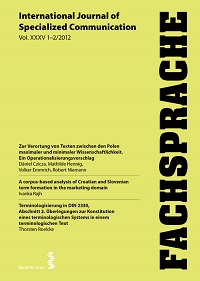Zur Verortung von Texten zwischen den Polen maximaler und minimaler Wissenschaftlichkeit. Ein Operationalisierungsvorschlag
##plugins.themes.bootstrap3.article.main##
##plugins.themes.bootstrap3.article.sidebar##
Abstract
In Fachsprache 1–2/2011 Czicza and Hennig proposed a model that explains correlations between grammatical features and pragmatic conditions in communication in sciences. This model now serves as a basis for the practical analysis of the scientific degree of any written text. The authors present a method of analyzing written texts concerning the four parameters ‚economy’, ‚precision’, ‚impersonalization’ and ‚discussion’. The method is being developed by the analysis of a prototypical scientific article on the one hand and a non-scientific text on the other hand. The two texts serve as the two poles of the scale of scientificity. Finally, the applicability of the model and its operationalization is being illustrated by the analysis of two examples of texts that are located between the two poles (one popular scientific text and one juridical teaching article).
Zitationsvorschlag
##plugins.themes.bootstrap3.article.details##
communication in sciences, special language, common language, reductive grammar, grammar-pragmatics-correlations, language variation

